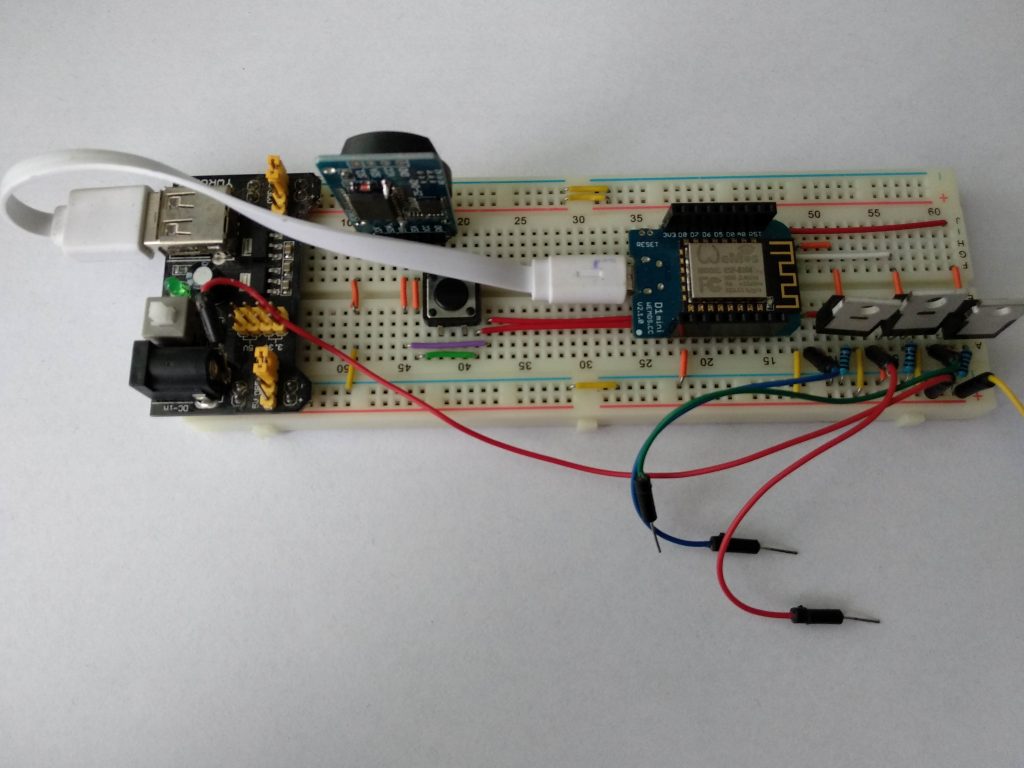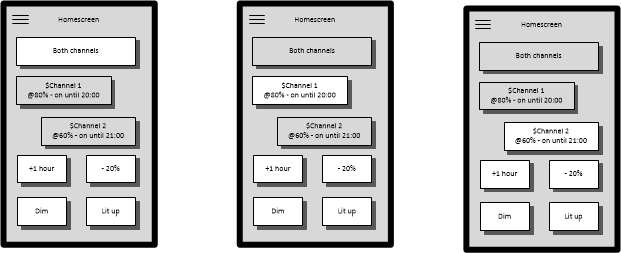Another part of the firmware is polished:
After thoughtful consideration, we have put a halt on the HW design stream. We will focus on the software on the prototype and solving the problem with mobile application.
So far, JT has created a fully functional prototype which is able to dim the LED lights in the required way.

We have received a very friendly quotation for executing the project:
LED PWM Supply Project
This quote covers the design of circuitry to enable a 2 channel PWM dimming controller. The input supply will be either 12V or 24V. The device will contain an ESP8266 and a ds3231 to use for control and connectivity. Using the ESP8266 as the PWM controller, we will design 2 channels of up to 4A of LED control. Each channel will be independently controlled and has independent monitoring and enabling abilities. The part used to generate the output, will allow for the outputs to be disconnected to give safety in a shorting event. Additionally the proper hookup of the ESP8266 and DS3231 will be performed, including creating a proper power supply for the devices which can operate off of an input from 12V to 24V.
This design will cover the creation of the schematics and board files in Eagle. We will work with you to come up with the final board size, and any mounting and sizing requirements. At the completion of the design, we will provide the Eagle files, Gerbers for fabrication of the boards, and a BOM for assembly. Additionally, we will provide support in helping to understand how to use the circuitry associated with driving the PWM signals and reading the status.
960 USD for this service seems like a very reasonable price.
Much more problematic is the situation with the client software. While JT is making great progress with the firmware on the ESP8266, there is no one on the project for the client application.
We understand that the application should be simple, build on PhoneGap, which should make it easier to find someone who will build the app, but so far, I have no luck persuading my friends and colleagues to team up with us on this project.
Dale is actually very good. He explains us a lot about the requirements and the design of the device. Take for example this wonderful explanation of the LED dimming options:
Just to clarify there are two ways to dim LEDs.
1. Adjust the current as it seems like you are implying. The issues with this is that LEDs do not have a linear response to current, so at 50% current you would not necessary be at 50% brightness. Additionally some LEDs shift “color” with current. If you are just doing white LEDs, they use a phosphor so this might be less, but a RGB led might have a more noticeable shift. Obviously this could be controlled by software.
2. Use PWM (Pulse width modulation). By varying the on time of the LEDs you are able to change the brightness. The possible downside to this is flicker, if the PWM rate isn’t a high enough frequency. The tradeoff here is resolution of dimming versus speed of the PWM. All of this would be under the software control of the ESP8266. We would just want to make sure we have hooked up the control lines to the PWM outputs of the ESP8266 and that it has the built in timer/counters to do this. (While you could do it using software, it would be much easier if you use the built in functions of the processor)
They are a bit different in terms of design requirements, so was just curious if using the current dimming is what you want, or is this more of a question you would want us to help you answer?
Of course we are deciding for the PWM technology.
I have received a lot of responses. The problem with contacting big companies for a job is that they usually want to charge a lot of money. So I am filtering out the proposals to do the job for 16.000 USD and I focus on talking to Dale, from a small studio from Oregon, USA who seems to understand what we need and is able to provide.
I have sent out a design service request to a selected group of companies and individuals I have googled in the past days.
Hopefully I will get some answers from the 22 mail that went out 🙂
Hello,
I am looking for someone to help me design a PCB (from features specification through schematic design to detailed PCB design for manufacturing).
Let me try to explain a bit better what I need :
I want to produce a device – LED dimmer configurable over WiFi. I need someone to actually design the circuits, identify needed components.
I know I want to use the ESP8266, which will talk to the RTC (eg ds3231) (because I am familiar with these components and I started to do development of SW for them ).
Then I believe there should be some n-mofsets, or darlington transistors to handle the 0-100% current intensity on the output, which shall be managed by the ESP8266.
I have in mind a PCB, that has on one side 1 barrel jack input of 12/24V with max 10A and will have 2 independent outputs (2 jack barrels, 4A max each), which will be adjustable for 0 – 100% output power.
The power output of each of the branches will be managed by the ESP8266, which will talk to the RTC (eg ds3231) for current time.
I have a very specific application that will run on both the ESP and the client application, that will talk to the module via WiFi.
The aim is to manufacture this and sell on the market. The schedule consists of 4 main areas:
I want to follow the simple path – design the HW, get the unit price quote (based on used components), produce prototype, develop SW (part 1+2), launch the product and start with made-to-order.
I hope my needs are clear and I hope to hear from you. Can you give me an estimation of price for the design of this (I guess for an expert this is very simple task). And for manufacturing a prototype (1-2 boards?)
Thanks,
My first thoughts about the application GUI. Apart of the scheduler, there will be a couple of buttons, which will have specific functions, which I expect to be used frequently during operation.
+1 hour button = will shift the scheduler for current phase by 1 hour
Dim – will the lights will turn off within 1-2 minutes
-20% – the lights intensity will be reduced by 20%. Valid for all hours until the lights will be completely out
Lit up – will set the lights to 100% within 1-2 minutes.
All of these options will be available for 1 or both of the light channels.

My first ideas on the logo for RMLD. I am no designer, I understand this has to be done by a professional graphic to be pretty.
In general, I am starting to think about the overall design of the device, the brand, logo, application, packaging, etc.
If this is really to happen, it is going to be quite a lot of work. Bring it on!!! J

Today, we had a serious discussion with JT about the future of the project. While JT sees this as a hoby project, goal of which is to build me a working prototype of the dimmer for my perusal, I see this as a fantastic opportunity to start a business. I believe we have discovered a fantastic hole on the market and it makes sense to purse it. In the discussion we came to the conclusion, that in order to make a product out of this, there are several areas of the project where we have insufficient knowledge and lack any experience. The main problem is the design of the device itself in terms of electronic components and the design of the PCB. We agree to push the project forward on two levels
The specification of the mobile app is taking shape. The largest part of the spec so far is detailed definition of the association flow, which will be a step-by-step initial setup of the device, in which user will choose to either use the device wifi, or to connect to the home wifi and in this case we need to make use of the SSDP discovery.